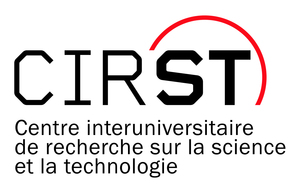About
This dashboard accompanies the report produced by the Centre interuniversitaire de recherche sur la science et la technologie (CIRST) for the Canada School of Public Service. Its objective is to illustrate applications for the implementation of the data architecture proposed within the framework of this project. The illustrated examples represent only a small part of the informational potential of the data contained in the RIASs. Each example features analyses or tools targeted to specific end users.
These analyses are possible due to two elements 1) the tags linking RIASs to other regulatory documents and 2) the translation of the textual data into machine-readable format.
This dashboard is produced for demonstration purposes only. Its reach is limited the illustration of the potential of a data architecture organized around RIASs. It is therefore a tool that has no research or informational value per se.
About the Data
The data used in this demo originates from a database compiled and annotated by Louis-Robert Beaulieu-Guay, Marc Tremblay-Faulkner and Éric Montpetit over the past 4 years. It brings together the RIAS accompanying the regulations created, amended or repealed between 1998 and 2019. The data was compiled using a web scraping tool and organized using pattern matching rules (regular expressions). The data are imperfect, since it was derived from PDF documents, but it still shows the value of a systematic organization of the Gazette publications into machine-readable format.
A sample of 50 RIAS is also featured in the dashboard. This sample was manually annotated specifically for this project.
References
Beaulieu-Guay Louis-Robert, Marc Tremblay-Faulkner Marc & Éric Montpetit. 2020. Does Business Influence Government Regulations? New Evidence from Canadian Impact Assessments. Regulation & Governance: Early view.
Beaulieu-Guay, Louis-Robert, Marc Tremblay Faulkner & Éric Montpetit. 2019. Chiffrer et définir la contrainte règlementaire canadienne à l’aide des Résumés d’Études d’Impact de la Règlementation. Paper presented at the 12e colloque du Centre d’Analyse des Politiques Publiques on Mai 16th 2019. Québec, QC : Université Laval.
Government of Canada. 2016. Counting Administrative Burden Regulatory Requirements. Available from URL: https://www.canada.ca/en/treasury-board-secretariat/services/federal-regulatory-management/administrative-burden-baseline/counting-regulatory-requirements.html.
Frehen, Lise & Louis-Robert Beaulieu-Guay. 2020. Beyond agenda setting: a topic model for European policy formulation. Paper presented at the Séminaire du Centre Montesquieu d'études de l'action publique on October 26th. Louvain-La-Neuve, BE : Université Catholique de Louvain.
Herzog, Alexander., Peter John & Slava J. Mikhaylov. 2018. Transfer topic labeling with domain-specific knowledge base: An analysis of UK House of Commons speeches 1935-2014, arXiv preprint arXiv:1806.00793.
Roberts, M. E., Stewart, B. M., & Tingley, D. 2019. Stm: An R package for structural topic models. Journal of Statistical Software, 91(1), 1-40.
Team
Marc Tremblay-Faulkner et Louis-Robert Beaulieu-Guay
Louis-Robert is a PhD candidate in political science at the University of Montreal under the supervision of Éric Montpetit. Marc, also a former student of Éric Montpetit, graduated recently and currently holds a position within the Quebec public service. Respectively, their research focuses on the impact of consultation in the development of Canadian federal regulations and the role of special interest groups' expertise in public policy forums, respectively.
Éric Montpetit
Éric is a professor of political science at the Université de Montréal and his research focuses on the impact of scientific knowledge on regulatory changes in Canada, the United States and Europe. He is responsible for the expertize, decision and public debate axis at the Interuniversity Research Center on Science and Technology (CIRST).
Louis Renaud-Desjardins et Philippe Nazair
Louis Renaud-Desjardins and Philippe Nazair are research officers at the CIRST digital initiatives office. Louis holds a master's degree in physics from the University of Montreal and a master's degree in atmospheric and oceanic sciences from McGill University. Philippe holds a master's degree in sociology from the University of Quebec in Montreal and a college diploma in computer science.
Contact
For additional information related to this project or for any further communication, please contact:
Louis-Robert Beaulieu-Guay
514-754-6289
3150 Rue Jean-Brillant, C-3112
Montréal, Québec, H3T 1N8
This analysis derives topics from the vocabulary found in RIASs. These topics represent the themes addressed by Canadian regulations between 1998 and 2019.
This analysis illustrates how, using the cleansed RIAS texts and accompanying metadata, this analysis illustrates how scholars could mobilize computer-assisted textual analysis techniques or machine learning to explore public policy issues. Analyzes like the one illustrated here have already been carried out on Canadian regulatory texts (Beaulieu-Guay et al. 2019), transcriptions of legislative speeches in the United Kingdom (Herzog et al. 2018), and texts of regulatory impact assessment conducted under the European Union authority (Frehen & Beaulieu-Guay 2020). The figures and graph shown here demonstrate that, once made accessible, the information contained within RIASs and accompanying documents accompanying them can shed light on several questions pertaining to public policy and public administration. In the case illustrated here, we used unsupervised machine learning techniques to enquire into the evolution of the Canadian regulatory agenda.
Technical details
Data: the texts of the RIAS accompanying 6,547 regulatory changes
Preprocessing: lemmatization of the text, removal of the most and least frequent terms (10% on each side)
Model: Structural topic model
Additional information: for the sake of clarity, the chosen parameters limit the model to 19 themes in order to facilitate interpretation. According to some empirical indicators, however, a more representative number of themes, according to some empirical indicators, would rather be around 30 or 35.
Explore the Weight of Topics by Ministry
This analysis counts the expressions (words) that may be associated with regulatory stringency in the texts of regulatory changes from 1998 to 2020. Based on the dictionary set up by the Treasury Board of Canada Secretariat (Canada 2016), we were able to identify each of the stringency-inducing expressions and associate them with the corresponding RIAS and some of its metadata (sponsor and year).
This information may be relevant to regulators seeking to gain an overview of the stringency of the Canadian regulatory body. Eventually, this index could be crossed with the NAICS codes to develop a sectoral analysis of the "regulatory burden" put on Canadian firms and businesses. As an indication, the RegData (Al-Ubaydli & McLaughlin 2017) project mobilizes this kind of analysis to document the accumulation of regulatory constraints in the United States. In Canada, our team (Beaulieu-Guay et al. 2020) used this index to establish a connection between the level of regulatory stringency and the mobilization of various stakeholders during public consultation periods.
Technical details
Data: the texts of 6,547 regulatory changes and the accompanying RIAS
Empirical strategy: use of a dictionary and rules based on regular expression
Regulatory Constraint Index by Year
Explore Regulatory Constraint Index by Sponsor by Year
These figures display the links between different regulatory changes. The relationships are based on the reference to a certain regulation or regulatory change found in the text of a different regulatory change.
These links can allow an administrator to quickly identify the pieces of regulation that refer to rules that they are planning to amend or repeal. This kind of network also helps assess the relative importance of certain regulations. The network was created by extracting and compiling references from the footnotes of regulatory change texts.
Technical Details
Data : Footnotes from 8630 regulatory change texts (this analysis includes SOR with Explanatory Notes and SI)
Model: The networks are plotted using the R library ggraph. The third graph allows the user to zoom and move around the nodes. It uses the R library visNetork. The position of the nodes are calculated using a force-directed graph drawing algorithm.
RIAS network
This is an alternate visualization of the previous analysis.
RIAS network
This tool illustrates how regulated parties and/or the public, could navigate an interface based on the data architecture. It allows one to carry out keyword searches; for example, a regulated party could browse the documents regulating its area of activity using NAICS codes or keywords.
This tool brings together a sample 50 manually-annotated regulatory changes, which have been manually annotated. The identification of tags and annotations could potentially be automated.
Technical details
This interactive table is generated using the R library DT.

